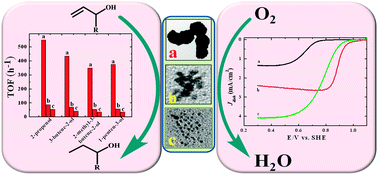Sara Coles is a guest web-writer for Catalysis Science & Technology. She currently works for Johnson Matthey in Royston, UK.
Shape controlled synthesis of catalytically active metal nanostructures is an important field of scientific research for both industry and academia. The arrangement of atoms on the particle surface is believed to play a critical role in the adsorption and desorption of substrates and products – which in turn affects the activity and selectivity of the catalyst. The chance to fine-tune these properties is too good to miss.
With this aim in mind, Sourov Ghosh and colleague, working in India, have experimented with different ways to shape platinum nanoparticles. Their report in Catalysis Science & Technology explains how they 
The peanut-like particles showed significantly higher specific activity towards the ORR than the aggregated dendrimer-like particles or conventional quasispherical platinum nanoparticles. This makes them a promising choice for the fuel cell cathode due to their ability to promote faster electron transfer kinetics.
Read more about this work in the full paper.
Shape-controlled synthesis of Pt nanostructures and evaluation of catalytic and electrocatalytic performance
Sourov Ghosh and C. Retna Raj
Catal. Sci. Technol., 2013, 3, 1078, DOI: 10.1039/c2cy20652h










